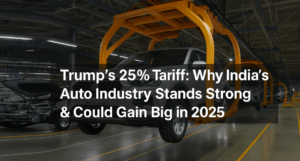Trump’s 25% Tariff: Why India’s Auto Industry Stands Strong & Could Gain Big in 2025
The 25% tariff on automobiles and auto parts imposed by the U.S. is unlikely to harm India’s auto industry and may even present new opportunities. India’s car exports to the U.S. are minimal, around $10 million annually, making the impact negligible. However, auto parts are a more significant sector, with $2.2 billion in exports, though this still accounts for less than 3% of U.S. imports. The tariff applies equally to all countries, so Indian suppliers won’t be at a disadvantage compared to competitors.
While some pressure may arise from importers asking Indian firms to absorb costs, India’s significantly lower labor costs—nearly 10 times cheaper than the U.S.—help maintain its competitive edge. Even with the tariff, Indian manufacturers retain a 45% cost advantage, making it difficult for U.S. producers to outprice them. Instead of seeing this as a threat, India should use this moment to expand its market share in the U.S. and push for better trade deals. If leveraged well, this could be an inflection point for India’s manufacturing sector, much like the 1990s economic reforms.

Trump’s 25% Tariff: Why India’s Auto Industry Stands Strong & Could Gain Big in 2025
The U.S. has announced a 25% tariff on imported cars and auto parts, set to take effect in early 2025. While this move has raised concerns globally, India’s auto industry is expected to remain largely unaffected—and may even benefit from the new policy.
Minimal Impact on India’s Car Exports
India exports very few cars to the U.S.—just around $10 million worth annually. Compared to major exporters like Japan, which ships billions of dollars’ worth of vehicles, India’s contribution is negligible. As a result, the new tariff will have little to no impact on Indian car exports.
Auto Parts Exports: A Mixed Scenario
India plays a bigger role in auto parts, exporting about $2.2 billion worth of components to the U.S. This accounts for nearly 30% of India’s total auto parts exports but still makes up less than 3% of America’s total auto parts imports.
The tariff primarily targets larger exporters like China, Canada, and Mexico, meaning India is not the main focus. However, Indian suppliers could face some indirect challenges.
Why Indian Auto Parts Makers May Stay Competitive
Since the 25% tariff applies uniformly to all exporting countries, Indian companies won’t be undercut by competitors. However, U.S. importers might pressure Indian suppliers to absorb part of the tariff cost, which could squeeze profit margins. Some Indian manufacturers have already begun cost-cutting measures in anticipation.
A bigger concern is whether U.S. manufacturers will use this tariff to boost domestic production and reduce reliance on imports. However, this is more likely to hurt high-cost suppliers from countries like Germany and Japan rather than low-cost producers such as India, Vietnam, and China.
India’s Cost Advantage Remains Strong
One of India’s biggest strengths is its low labor costs. A factory worker in India earns around ₹30,000–₹40,000 per month, while a U.S. worker makes at least $4,000 (over ₹330,000)—a tenfold difference.
While the U.S. compensates with higher automation and productivity (about two to three times that of India), Indian labor remains far cheaper. Labor costs in India, including wages and management salaries, typically make up only 12–15% of total production expenses.
Even with a 25% tariff, Indian products still hold a cost advantage of around 45% over U.S.-made goods. In industries where labor costs are a bigger factor, this gap widens further, making it difficult for American manufacturers to compete.
An Opportunity to Grow Market Share
Rather than worrying about the tariff, India should see this as an opportunity to expand its presence in the U.S. market. Thanks to its cost advantages, Indian auto parts makers can remain competitive despite the additional duty.
Some fear that U.S. manufacturers will ramp up production to replace Indian imports, but this concern may be exaggerated. American companies are more likely to focus on cutting expensive imports from high-cost countries rather than cheaper alternatives like India.
A Strategic Moment for India
The Indian government should use this situation to negotiate better trade terms and push for higher exports. History has shown that economic reforms during challenging times—like those introduced in the early 1990s—can transform the economy. If handled wisely, these tariffs could mark a turning point for India’s manufacturing sector.
As the saying goes, “Never let a crisis go to waste.” Instead of seeing this as a setback, India should seize the moment to strengthen its position in the global auto industry. By leveraging its cost advantages and improving trade policies, India can turn this challenge into an opportunity.
You must be logged in to post a comment.